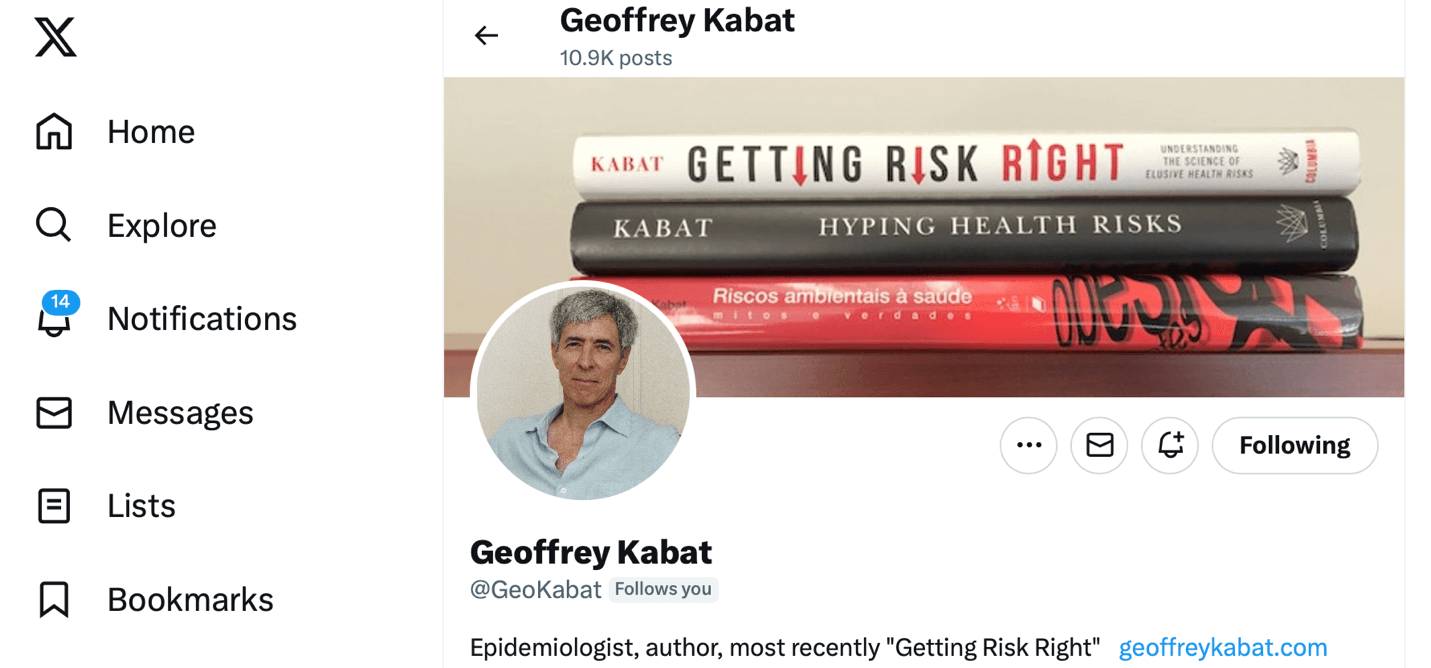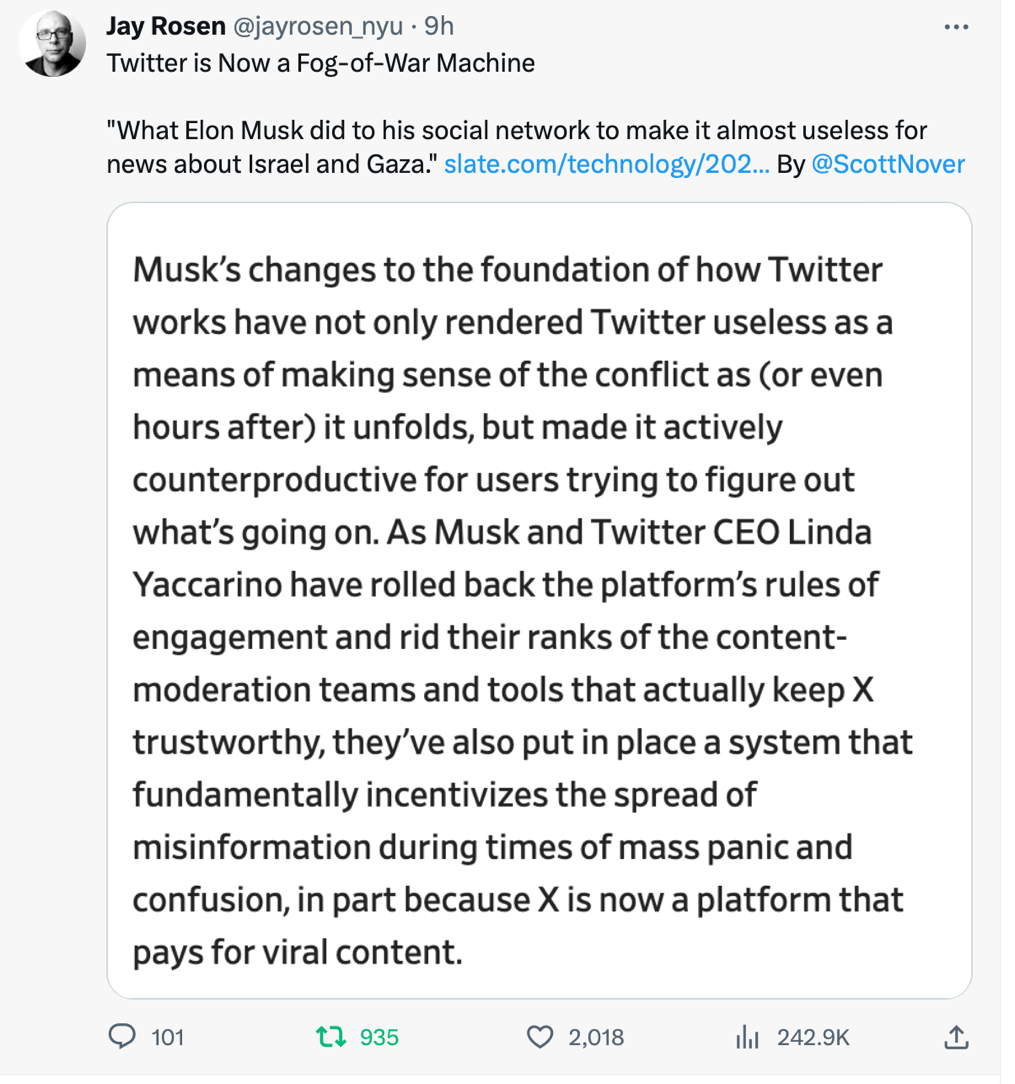While many users are fleeing Twitter/X in disgust at the turn it has taken toward encouraging the spread of conspiracy theories, antisemitism and hate under Elon Musk’s leadership, a cadre of established users are remaining to fight against these very trends.
My corner of Twitter
I joined Twitter in January 2011, mainly to follow discussions in my field of epidemiology, including discussions of topics concerning potential health risks, such as cell phones, the chemical BPA, the weedkiller glyphosate, and vaccines.

Gradually, I added people who had knowledge in areas that interested me and who wrote with verve and authority. Over time, my curated feed grew to about six hundred people in areas including medicine, public health, biology, biotech, history, literature, politics, journalism, psychology and more.
Twitter put me in touch with people who had vital information, as well as insight, to share about subjects I was interested in or writing about. This became a matter of life-or-death during the pandemic, when in-person contact was curtailed. Having access to the latest findings posted by people like Eric Topol, Peter Hotez, Laurie Garrett, Michael Mina and many others made it possible to follow the changes in SARS-CoV-2 over time as well as the effectiveness of vaccines and other public health measures.
Although I was aware that there were many more worthwhile people I could follow, the few I chose was all I could manage for a half hour or so each day. I was content to get a sampling of what seemed to be highly informed and interesting views on topics that interested me. Occasionally, I would “unfollow” an account I was following if I felt that the writer descended into polemics or flagrant disinformation.
On this basis, my Twitter feed — my corner of Twitter — always provided plenty of thoughtful commentary on the news, politics, health and other topics.
Toward the end of 2022, I became aware that several people I was following and admired were abandoning the site in disgust, with some of them switching to other social media sites. I regretted losing these voices, but I was only vaguely aware of what was behind these defections. I don’t recall seeing any detailed explanation of anyone’s reasons for leaving. Still, most of the people I was following stayed on the site, even though some expressed ambivalence and seemed to be considering leaving.
Now, even for someone with my blinkered view, it has become impossible to ignore how the Twitter that I only used in a limited, highly curated, way has been turned into a mechanism for amplifying conflict and distrust as a means of boosting engagement and increasing revenue.
The case against Twitter/X
In early October, Bloomberg technology columnist Dave Lee announced that he had decided to step away from Twitter/X as an engaged user, although he would continue to report on it. Lee wrote:
One thing the prior Twitter management didn’t do is actively make things worse. When Musk introduced creator payments in July, he splashed rocket fuel over the darkest elements of the platform. These kinds of posts always existed, in no small number, but are now the despicable main event. There’s money to be made. X’s new incentive structure has turned the site into a hive of so-called engagement farming — posts designed with the sole intent to elicit literally any kind of response: laughter, sadness, fear. Or the best one: hate. Hate is what truly juices the numbers.
Lee concluded:
X is now an app that forcibly puts abhorrent content into users’ feeds and then rewards the people who were the most successful in producing it, egging them on to do it again and again and to make it part of their living. Know this: As the scramble for attention increases, the content will need to become more violent, more tragic and more divisive to stand out. More car crashes, high school fights and public humiliation.
Lee was hardly alone in his distress over the changes made under Musk. Here are some recent posts on Twitter/X from several people I follow reflecting on all these changes. Each poster is in a different discipline but their point is the same:



Three weeks ago, speaking on the PBS NewsHour, information warfare researcher Emerson Brooking succinctly analyzed the impact of Musk’s refashioning of the site to “tear down all gatekeepers, even when gatekeepers are performing an invaluable function.”
The first big thing he’s done is essentially remove the ability to identify and verify credible accounts, journalists or other people who have been vetted and trusted. And second, he’s introduced a for-profit motive which didn’t previously exist on the platform, which incentivizes accounts, often under specious identities, to spread false content as quickly as possible in order to maximize their own revenue.
And all this matters because so many policy makers, so many journalists, so many people still use this platform to understand what’s happening. Now it’s become much harder.
Any event can provide the grist for engagement, whether questioning how deadly the novel coronavirus is or documenting Hamas’ attacks on civilians in southern Israel and the Israeli response. However, in wartime, misinformation and unverified reports take on a qualitatively different character, with the power to ignite responses from local populations, neighboring militias and powerful nation-states, as we are seeing unfold in the eastern Mediterranean.
CNN has reported that some of the biggest spreaders of false information about the Israel-Hamas war on Twitter/X “are premium, so-called ‘verified’ accounts that pay the social media company formerly known as Twitter to promote their posts to boost visibility.”
CNN cited a report from NewsGuard, an information analysis company, which identified seven accounts that qualified as “misinformation superspreaders,” sharing widely discredited claims about recent events in Israel and Gaza accompanied by videos from earlier, unrelated conflicts and even video games. NewsGuard has launched what it calls an Israel-Hamas War Tracking Center to monitor the tsunami of disinformation.

It also analyzed 250 of the most highly-circulated posts from the first week of the conflict containing some of the most common false or unsubstantiated claims about events. These posts were viewed more than 100 million times in just one week. The company said that 186 of the 250 posts, or 75 percent, originated from premium X accounts.
In this perverse way, Musk’s X incentivizes spreaders of misinformation by promoting their “verified” accounts in exchange for a $8 monthly fee, and enabling them to receive payments from the site.
Two Twitters
There are two conflicting Twitters. One is the company that has mostly been in the red since its founding in 2006 and that Musk is attempting to put on a sound financial footing. To achieve this aim, he is reshaping X to mirror his worldview. According to Axios, X is already evolving into another company altogether, “a Musk-run social universe that pulls together 24 years of his ideas and wildest fantasies.” In pursuit of his vision, Musk is doing everything he can to engage users by promoting misinformation and allowing antisemitism and conspiracy theories to flourish.
The second Twitter, which I’ve been tuned in to for more than a decade, provides valuable information and commentary posted by people with no agenda other than to parse the facts relevant to a question of interest.
These two Twitters represent different principles and models of social engagement — between thinking fast and slow, between the reptilian brain and the frontal cortex, between the mob and the individual. Currently, it comes down to the difference between ensnaring followers in conspiracy theories versus trying to identify new insights to improve one’s understanding of some phenomenon.
Health Nerd on ivermectin
Amidst the noise and toxicity, to come across a carefully-explained, fact-based treatment of a question or the dissection of a false notion that has gained currency inspires gratitude.
Here is one example from many I could have chosen.
Early in the coronavirus pandemic, when patients were dying on ventilators in hospitals and before there was a vaccine or effective treatment, the anti-malaria drug hydroxychloroquine and the antiparasitic drug ivermectin were touted to provide dramatic protection. Sales of both drugs skyrocketed and store shelves emptied.
Gideon Meyerowitz-Katz, aka Health Nerd, an Australian epidemiologist, was appalled that so many politicians (including President Trump), self-appointed experts and disinformation entrepreneurs promoted these drugs. He was moved to respond on Twitter. In a 25-Tweet thread, he led the reader through an early paper purporting to provide evidence of the effectiveness of ivermectin in preventing Covid-19 — and why it was problematic.


Even a cursory look at the paper revealed red flags — conflicting numbers of study subjects in different parts of the paper; its appearance in a highly questionable journal; and the fact that the drug appeared to be close to 100 percent effective, something unheard of in medicine.
In retrospect, it turns out that this and several other papers that were heralded as game-changers were fraudulent. But, in an atmosphere of panic and terror, people were desperate for an effective treatment, and charlatans and some clueless physicians latched onto the “evidence,” based on hearsay and apparently without giving it even the most cursory look. In fact, few people are in a position to actually read and dissect papers claiming stunning results.
As Meyerowitz-Katz later explained in a superb essay in Medical News Today published in December 2021, what was lost sight of is something that every health scientist knows — or should know: much of what is published is either false or over-stated. Reviewers of papers In epidemiology that, no matter how bad and no matter how many times it is rejected, it can end up getting published somewhere.
When we most needed effective fact-checking, our grand institutions of scientific research instead reviewed studies in a matter of days, if not hours, and posted fraudulent studies online to be shared across the world.
It’s tempting to say that research into ivermectin is uniquely flawed, but that’s clearly not true — realistically, it would be remarkable if a broken system produced only one failure.
Going against the current
Over the past dozen years, Twitter has provided an invaluable forum for making breaking news accessible in real-time, exchanging ideas, circulating information, including scholarly papers and critiquing false narratives that have gained currency.
Despite the atmosphere of self-indulgence and narcissism that dominates so much of Twitter/X under Elon Musk, there are still ongoing, disciplined efforts, by people like Meyerowitz-Katz, to leverage social media to bring knowledge to bear on important questions and to challenge misinformation — not for attention or monetary gain but to contribute to the common good.
One hopes that these dedicated people will be able to continue to provide an alternative to the direction Twitter/X appears to be headed in — and to champion a model of rational exchange and discourse.
Geoffrey Kabat is a cancer epidemiologist and the author of Hyping Health Risks: Environmental Hazards in Daily Life and the Science of Epidemiology and Getting Risk Right: Understanding Science of Elusive Health Risks. Find Geoffrey on X @GeoKabat































